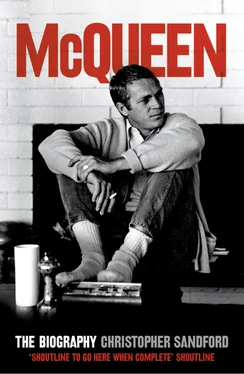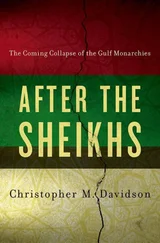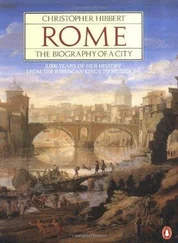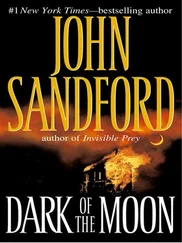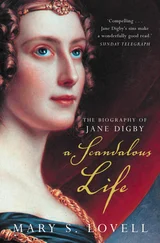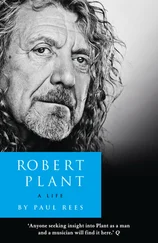As an actor, McQueen was emerging almost fully formed. He was poised; he was go-getting. He was also – and always – spoiling for a fight. In his wordless way, a clear plan of attack grew out of his five-year apprenticeship.
By his twenty-fifth birthday Steve had been in three plays far off Broadway, and had a reputation for being both talented and difficult. The money from these productions was long since gone. Early that winter he was forced to trade down to a fifth-floor slum on East 10th Street with a tin bathtub in the kitchen. His previous place, he now decided, was ‘fucking near the Plaza’ by comparison. McQueen sold the MG and took part-time work as a mechanic in an Upper West Side garage, where he once suffered the indignity of having to service James Dean’s Harley. Something about the flush to his face when he handed back the keys suggested, to a mutual friend, that ‘Steve was jealous of Jimmy, and was busy figuring out how to deal with it’. Aside from a brief encounter at Jerry’s, that was the last time the two actors ever met.
Steve did, however, reluctantly put in several man-hours of hard work with Julian. They eventually got back in touch. Whatever his normal code on women, these tedious and often trying interventions were much to McQueen’s credit. Two or three times that winter his mother called him to discharge her from hospital, where she was being treated for acute alcoholism. He always went, walking her home from Bellevue through Gramercy Park and down Irving to East 18th, where Julian liked to stop in for a beer at Pete’s Tavern. By any account there was something heroic about Steve’s self-control: he was able to rally round Julian while never again daring to trust, let alone to love her. As Dora Yanni quite rightly says, ‘That woman put the iron into Steve’s soul.’ Iron, she adds, that ran deeper than blood. Without Julian he would never have been a great tragedian, as opposed to another pantomime punk figure. Yanni happened to see McQueen hurrying into the hospital one evening, his white gym shoes snapping against the polished floor. ‘She’s frothing,’ he told her.
Implacably, Julian’s influence was everywhere.
Meanwhile Steve continued, as Yanni herself knew, to ‘root himself stupid’ around New York. For other actors the most seductive aspect of Big Mac may not have been his innocence, but the startling, pre-emptive willingness to do literally anything to make it. When McQueen auditioned for Strasberg, he was one of only five actors out of 2000 applicants to be accepted that season. He also lobbied Witt nonstop for work. Later that spring of 1955 he landed a spot in an hour-long dramatic NBC anthology series, the Goodyear Playhouse. Both ten ratings points lower and twenty IQ points higher than current TV fare like I Love Lucy, The Chivington Raid , broadcast on 27 March, was McQueen’s screen debut.
He followed it by launching himself, as Yanni says anachronistically, ‘like a Scud missile’ at a play called Two Fingers of Pride. This pro-labour harangue, set in the New York docks and broadly in the mould of On the Waterfront , was being cast by its writer Jim Longhi and the director Jack Garfein. Steve read for the second lead, having assured them that he, like his character, was Italian-American and twenty-two years old. Neither was true, but otherwise McQueen fitted the part well. He then borrowed $35 (never repaid) to buy his first Actors Equity card. Even though the show never transferred from summer stock in Ogunquit, Maine, Steve’s ‘original, primitive’ portrayal of Nino the longshoreman was noted warmly by the New York Post and without insult in the News. Garfein managed to get McQueen an appointment with the talent agency MCA. Steve arrived for his interview at the glass-and-marble office on Madison Avenue by riding his Harley through the lobby, into the lift, and up to the eleventh floor. MCA accepted him.
Later that winter the director Robert Wise was in New York casting his biopic Somebody Up There Likes Me , set in the roasted light of Hell’s Kitchen and the prize ring. Wise remembers an audition when ‘this kid came in, cocky, wearing a sport jacket and a beanie cap, and told me: “I’m your man.’” There were dozens of other actors in immaculate black denim up for the bit part of Fidel (often wrongly given as Fido), the blade-wielding punk. Wise had never heard of McQueen. He did, however, recognise the potential of the ‘lean, tense boy you felt could slug you as fast as smile’ whom MCA brought him. Steve got the job. For $19 per diem (rising to $50 on the few days he had any lines) he got to play out scenes from his own adolescence.
Somebody was a remarkable case study of the transaction between life and art, at its core dramatising the career of the boxer Rocky Graziano. McQueen came on as a greaser, whose sudden eruptions of energy – ‘You lookin’ at me ?’ – lent, with their De Niro-like emphasis, a touch of added menace to the proceedings. His safari down the back alleys of New York was freighted with three obsessions—hubcaps, pool and mob violence – as well as a touch of mimicry, specifically a disgruntled Brando mushmouth. It was the first, though not the last instance of Steve’s knack for projecting his own life’s path on screen. Somebody was good, hard-bitten stuff.
As a member of Graziano’s street gang Steve offered his usual concentration, quickness and stern, appraising gaze. Appearing in only the first fifteen minutes of the film, he cut a slick dash as well as a tone that was satirical and vicious to the outside world, yet warm and accepting of friends – the distinctive McQueen tone, in his first fully confident role. Following the style of the movie as a whole, Steve’s movements were crisp and taut, his voice gruff, his type now cast as a threatening hardnut, yet whose performance was never sacrificed to the action. Mostly, of course, the critics still ignored him. McQueen’s role was uncredited, and thus somewhat below a Variety ’s radar. His few notices in the trades were good enough, but what struck Steve more, if possible, was the wallop he had on Hollywood. Men like Wise and MCA’s John Foreman now sat up for the ‘kid’ whose talent for engaging menace was complemented nicely by a slit mouth and the shaggy-pup eyes.
The man who played top dog to Steve’s Fido was a thirty-year-old actor in only his own second role. From then on, Paul Newman’s career became a kind of pace car for McQueen’s. Steve’s first director is only the most compelling witness to the fact that it was ‘undeclared war’ between them, two physical types whose commonplace, yet heroic qualities inspired, on one level, several PhD theses and, striking a lower note on the academic scale, Erica Jong’s orgasm in Esquire. ‘Who has the bluest eyes? Newman or McQueen? It’s difficult to say, but McQueen’s twinkle more. He makes me think of all those leathery-necked cowboys at remote truck stops in Nevada. Does he wear pointy boots? And does he take them off when he screws?’ The most charitable reading of this rivalry is that it neatly relit the torch once carried by Steve for James Dean (originally slated for the Graziano role) before the latter died in September 1955. It reached its shining apogee, or leaden nadir, when the two stars came to debate their billing, eighteen years later, in The Towering Inferno. A compromise was eventually reached whereby McQueen’s name would be on the left, and Newman’s a shade higher, exactly a foot to the right, on the marquee. Steve knew very well the direction in which people read. That twelve-inch gap was supremacy superbly controlled.
Mutual ambivalence, meanwhile, bordered on open war. Only this can explain the bile which seeped out of McQueen’s private assessment of Newman like an oil leak. ‘Fuckwit’, he dubbed him at moments of stress.
Читать дальше
